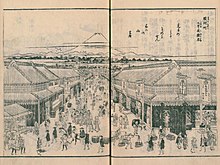178:, decided Edo needed one, too. He is thought to have begun work around 1791 and is known to have gotten permission to publish and written a foreword, but he died before he could finish. From this point forward, Yukio's son-in-law Saitō Yukitaka Agatamaro (1772–1818) began work, undertaking new research to add new sites and re-researching other information; but he, too, died suddenly shortly before he could complete his task. Yukitaka's son, Saitō Yukinari Gesshin (1804–1878), was only 15 at the time, so he was not able to take up immediately where his father had left off; nonetheless, Yukinari was determined to complete his father's and grandfather's labor of love. When he finally managed to bring all the research, writing, editing, and correcting to fruition in 1834, he delivered to the public an innovative and highly detailed
24:
101:
113:
89:
316:
205:, then it moves on to describe the city and its surroundings block by block, town by town, in a manner reminiscent of a walk-through of each area with stops at famous sites. The descriptions often include information about the origins of the place or site's name and its history, as well as quotations from well-known works of literature (such as
189:(1778–1843). His illustrations are credited with contributing as much to the work's fame and long popularity—people still refer to it today for walking tours of historical sites—as does the prose.
158:
in 20 books divided among seven volumes. Initially published in 1834 (volumes 1–3, 10 books) and republished in 1836 (volumes 4–7, all 20 books) with slight revisions—i.e., all during the late
174:
It took form over a span of more than 40 years. It was conceived by Saitō Gesshin (1737–1799) who, influenced by the proliferation of famous site guides about places in Japan's
220:
goes beyond the confines of the Edo proper and includes descriptions and illustrations of surrounding areas as well, venturing as far away as today's
117:
53:
327:
300:
279:
272:
75:
46:
320:
182:
that even today serves as a valuable resource for academic and hobby historians of late–Edo-period Tokyo.
396:
386:
155:
376:
371:
340:
267:, revised edition), volumes 1–6. Chikuma Gakugei Bunko pocket book series, Chikuma Shobō, 1996–1997.
36:
40:
32:
381:
57:
162:(1603–1867), it became an immediate hit and prompted a “boom” in the publication of further
8:
356:
352:
348:
344:
296:
275:
268:
391:
246:
225:
198:
186:
179:
206:
332:
with scans of the original work, accompanied by photos of the same places today
229:
100:
365:
175:
295:
dictionary). Chikuma
Gakugei Bunko pocket book series, Chikuma Shobō, 1997.
221:
202:
159:
105:
112:
233:
88:
315:
139:
210:
152:
144:
148:
137:
is an illustrated guide describing famous places, called
96:
depicting Suruga-chō, illustration by
Hasegawa Settan
201:, the settlement of Edo, and the founding of the
363:
197:The account starts by explaining the history of
45:but its sources remain unclear because it lacks
130:
287:Ichiko, Natsuo and Suzuki, Ken’ichi, eds.
259:Ichiko, Natsuo and Suzuki, Ken’ichi, eds.
143:, and depicting their scenery in pre-1868
76:Learn how and when to remove this message
111:
99:
87:
364:
339:Scans of various manuscripts at the
17:
13:
14:
408:
309:
314:
22:
135:, "Guide to famous Edo sites")
1:
253:
156:woodblock printing techniques
328:A walk-through of scenes in
7:
239:
10:
413:
192:
169:
341:Waseda University Library
131:
166:(“famous site guides”).
31:This article includes a
151:. It was printed using
60:more precise citations.
261:Shintei Edo Meisho Zue
185:It was illustrated by
120:
109:
97:
323:at Wikimedia Commons
115:
103:
91:
289:Edo Meisho Zue Jiten
213:) that mention it.
397:Travel guide books
387:Asian travel books
232:to the north, and
216:In overall scope,
121:
110:
98:
33:list of references
319:Media related to
86:
85:
78:
404:
377:Edo-period works
372:Culture in Tokyo
336:
318:
305:
284:
247:Owari meisho zue
199:Musashi Province
147:, then known as
136:
134:
133:
81:
74:
70:
67:
61:
56:this article by
47:inline citations
26:
25:
18:
412:
411:
407:
406:
405:
403:
402:
401:
362:
361:
334:
312:
303:
282:
256:
242:
195:
187:Hasegawa Settan
180:human geography
172:
128:
92:Scene from the
82:
71:
65:
62:
51:
37:related reading
27:
23:
12:
11:
5:
410:
400:
399:
394:
389:
384:
382:Japanese books
379:
374:
360:
359:
337:
330:Edo Meisho Zue
321:Edo meisho zue
311:
310:External links
308:
307:
306:
293:Edo Meisho Zue
285:
265:Edo Meisho Zue
255:
252:
251:
250:
241:
238:
236:to the south.
218:Edo Meishō Zue
194:
191:
171:
168:
125:Edo meisho zue
118:Fudo Waterfall
94:Edo meisho Zue
84:
83:
41:external links
30:
28:
21:
9:
6:
4:
3:
2:
409:
398:
395:
393:
390:
388:
385:
383:
380:
378:
375:
373:
370:
369:
367:
358:
354:
350:
346:
342:
338:
335:(in Japanese)
333:
331:
326:
325:
324:
322:
317:
304:(in Japanese)
302:
301:4-480-08338-3
298:
294:
290:
286:
283:(in Japanese)
281:
280:4-480-08316-2
277:
274:
273:4-480-08311-1
270:
266:
262:
258:
257:
249:
248:
244:
243:
237:
235:
231:
228:to the east,
227:
224:to the west,
223:
219:
214:
212:
208:
204:
200:
190:
188:
183:
181:
177:
176:Kansai region
167:
165:
161:
157:
154:
150:
146:
142:
141:
127:
126:
119:
114:
107:
102:
95:
90:
80:
77:
69:
66:December 2009
59:
55:
49:
48:
42:
38:
34:
29:
20:
19:
16:
329:
313:
292:
288:
264:
260:
245:
217:
215:
207:Matsuo Bashō
196:
184:
173:
163:
138:
124:
123:
122:
93:
72:
63:
52:Please help
44:
15:
58:introducing
366:Categories
254:References
203:Edo Castle
164:meisho zue
160:Edo period
106:Nihonbashi
226:Funabashi
116:Scene of
104:Scene of
240:See also
234:Yokohama
153:Japanese
392:Ukiyo-e
193:Content
170:History
54:improve
299:
278:
271:
140:meisho
132:江戸名所図会
230:Ōmiya
211:haiku
145:Tokyo
39:, or
297:ISBN
276:ISBN
269:ISBN
222:Hino
108:area
209:’s
149:Edo
368::
355:,
351:,
347:,
343::
43:,
35:,
357:4
353:3
349:2
345:1
291:(
263:(
129:(
79:)
73:(
68:)
64:(
50:.
Text is available under the Creative Commons Attribution-ShareAlike License. Additional terms may apply.


